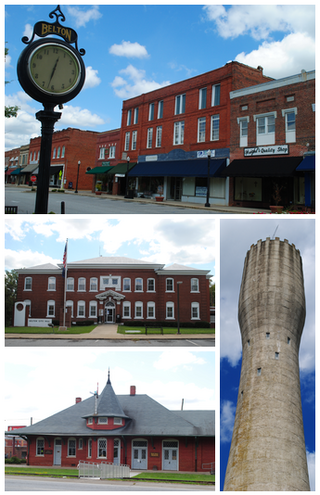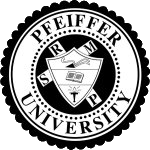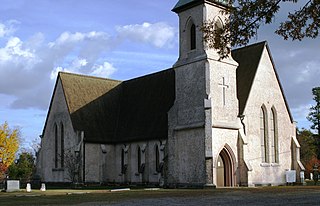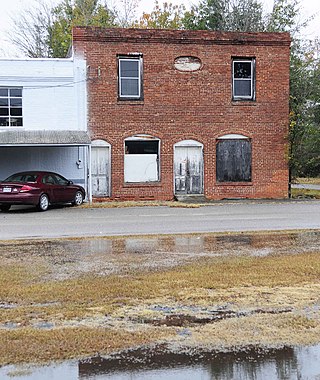
Anderson is a city in and the county seat of Anderson County, South Carolina, United States. The population was 28,106 at the 2020 census, making it the 16th-most populous city in South Carolina. It is one of the principal cities in the Greenville-Anderson-Greer, SC Metropolitan Statistical Area, which had an estimated population of 975,480 in 2023. It is included in the larger Greenville-Spartanburg-Anderson, SC Combined Statistical Area, which had an estimated population of 1,590,636 in 2023. It is just off Interstate 85 and is 120 miles (190 km) from Atlanta and 140 miles (230 km) from Charlotte. Anderson is the smallest of the three primary cities that make up the Upstate region, and is nicknamed the "Electric City" and the "Friendliest City in South Carolina".

Belton is a city in eastern Anderson County, South Carolina. The population was 4,134 at the 2010 census.

Pfeiffer University is a private university in Misenheimer, North Carolina. It is affiliated with the United Methodist Church.

This is a list of the properties and historic districts in each of the 46 counties of South Carolina that are designated National Register of Historic Places.

The Church of the Holy Cross is a historic Anglican church at 335 North Kings Highway in Stateburg, South Carolina. Built in 1850-52 to a design by noted South Carolina architect Edward C. Jones, it is a notable example of rammed earth construction with relatively high style Gothic Revival styling. It was designated a National Historic Landmark for its architecture in 1973.

The Dillon County Courthouse, built in 1911, is a historic courthouse located at 301 West Main Street in the city of Dillon in Dillon County, South Carolina. It was designed in the Classical Revival style by Darlington native William Augustus Edwards who designed eight other South Carolina courthouses as well as academic buildings at 12 institutions in Florida, Georgia and South Carolina. Dillon County was created in 1910 and this is the only courthouse it has ever had. On October 30, 1981, it was added to the National Register of Historic Places. It is located in the Dillon Downtown Historic District.

Pendleton Historic District in Pendleton, South Carolina is a historic district which is located mostly in Anderson County, South Carolina and partly in Pickens County, South Carolina. The district was listed on the National Register of Historic Places in 1970. The historic district includes the town of Pendleton and its immediate surroundings plus a large tract west towards Lake Hartwell to include the Hopewell Keowee Monument and the Treaty Oak Monument. The entire historic district covers an area of over 6,300 acres (25 km2).

This is a list of the National Register of Historic Places listings in Anderson County, South Carolina.

Galivants Ferry Historic District is a national historic district located at Galivants Ferry in Horry County, South Carolina. It encompasses 28 contributing buildings that reflect the agricultural heritage of Galivants Ferry and of the larger Pee Dee region. Included are tenant farmer houses, storage barns, tobacco packhouses, curing barns, and sheds. They include the home of the Holliday family and a church that sits at the edge of a long stretch of tobacco fields on Pee Dee Road. Also included is a filling station along U.S. Route 501. The two-story white brick John Monroe Johnson Holliday House was completed in 1950 and based on a house George Holliday built in the 1920s which burned in 1943. It is described as "owing much to the Colonial Revival and Greek Revival styles."

Robertville Baptist Church is a historic Southern Baptist church located at the junction of U.S. 321 and CR 26 in Robertville, Jasper County, South Carolina. It was built about 1847, and is a one-story, small frame building with Greek Revival and Gothic Revival details. The portico is supported by two plain Doric order columns. The building was originally occupied by the Ascension Episcopal Church of Gillisonville, and purchased by Robertville Baptists and moved to its present location about 1867. Robertville Baptist Church was organized in 1781 and considered the "Mother of Churches" in the area.

The Brattonsville Historic District is a historic district and unincorporated community in York County, South Carolina. It includes three homes built between 1776 and 1855 by the Brattons, a prominent family of York County. It was named to the National Register of Historic Places in 1971.

The Salley Historic District, located in Salley, South Carolina, consists of 99 contributing structures and 51 non-contributing resources, and provides a good example of a South Carolina rural community during the late nineteenth and early twentieth centuries. The town, located in Aiken County, South Carolina and incorporated in 1887, is named after D. H. Salley, owner of a large nearby plantation who was instrumental in the area's original development. The Salley Historic District was listed on the National Register of Historic Places on October 27, 2000.

The Kennedy Street School is located near the downtown area of Anderson, South Carolina. It was constructed in 1913, and is considered historically significant primarily because its architectural style is considered representative and typical of the Commercial style with Classical Revival details favored in the first quarter of the 20th century. The auditorium, added in 1960, is an excellent example of Modern style architecture. The 1913 school building was designed by architect Joseph Huntley Casey of Anderson, S.C. The Kennedy Street School was listed in the National Register on October 24, 2007.

The North Anderson Historic District, located in Anderson, South Carolina. The historic district is an architecturally significant area that offers an impressive collection of 20th century Revivals and American Movements. Further, the district is noteworthy for it further represents the development and transition of Anderson from a rural community to a planned city with well-thought out streets and neighborhoods. The district consists of over 147 homes, a number of garages and a few parks. Architectural styles include early twentieth century Revival styles including Tudor, Colonial, and Neo-Classical. The district was listed in the National Register of Historic Places on July 31, 2008.

The Ralph John Ramer House, is located near the downtown area of Anderson, South Carolina. The house was built in 1930 and is historically significant as an excellent example of an early-20th century Tudor Revival residence. Ramer was a leading Anderson businessman, government official, military officer and civic leader. Much of the noteworthy architectural detail of this house can be viewed from the public road that fronts the grounds. The house was listed in the National Register on February 10, 1992.

Gaffney Commercial Historic District national historic district located at Gaffney, Cherokee County, South Carolina. The district encompasses 41 contributing building in the central business district of Gaffney. Most of the buildings were built after 1900 and before 1930 and are primarily commercial buildings in vernacular commercial interpretations of the Italianate, Romanesque Revival, Renaissance Revival, Art Deco, and Neoclassical styles. All of the buildings are of brick construction and vary from one to four stories in height. The downtown area, which continues to be a center of Gaffney commerce, retains much of its early 20th century character.

Edgefield Historic District is a national historic district located at Edgefield, Edgefield County, South Carolina. The district encompasses 33 contributing buildings, 6 contributing sites, and 1 contributing object in the town of Edgefield. The buildings center on the landscaped village green, and includes forty 19th century buildings, three of which are house museums. There are a number of 19th century Greek Revival style homes, while others are noted for beautiful Federal style fanlights and unusual doorways. Other district properties include Victorian influenced homes and downtown commercial buildings. Five churches represent the Georgian, Victorian Gothic, and modified Gothic architectural styles. Notable buildings include the Edgefield County Courthouse, Trinity Episcopal Church and Rectory, St. Mary's Catholic Church, Halcyon Grove, Oakley Park, Carroll Hill, Blocker House, Yarborough House, and Padgett House.

Winnsboro Historic District is a national historic district located at Winnsboro, Fairfield County, South Carolina. The district encompasses 33 contributing buildings and 1 contributing site in the county seat of Winnsboro. The district features a wide range of architectural styles, from early simple frame houses that reflect utilitarian aspects of the Scotch-Irish, the first principal settlers, to pronounced styles such as Federal and Greek Revival. Many residences are typical upcountry frame houses, built in an L-shape with long piazzas running across the front. Notable buildings include the Town Clock, Fairfield County Courthouse, Thespian Hall, Fairfield Country Club, Mt. Zion Elementary, the separately listed Ketchin Building, Beatty House, Wolfe House, Kirkpatrick House, Neil House, and Williford House / Town Hall. The Fairfield Country Club was built in 1822 under the supervision of Robert Mills.

The Foley Downtown Historic District, in Foley, Alabama, United States, is a historic district that was listed on the National Register of Historic Places in 2005.























